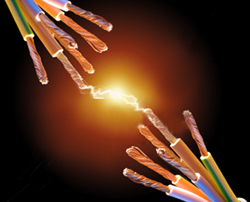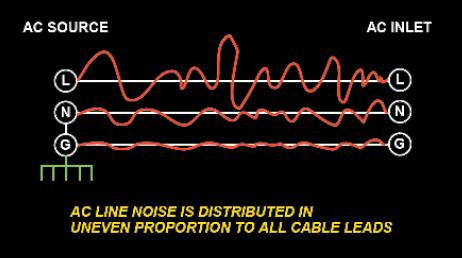
Will Balanced Suffice?
The second type of noise found with AC power is called transverse mode, and it’s essentially the opposite of common mode in that the noise does not attach itself to the lines in even proportion. (Figure 4)
Also, transverse mode is even more devastating than common mode, and any common mode filter design (including symmetrically balanced) is generally useless in defeating it.
This is important to understand, because there are those in our industry who would have us believe that “balanced power” alone will suffice in the quest to reduce AC noise.
Transverse mode noise is typically produced by motors, appliances, switching power supplies and digital processing circuits. Significantly reducing this noise requires a low-pass filter of considerable range.
Here’s why. Recall the previously mentioned dramatic increase in AC line noise seen in the last 20 years. What’s just as critical is that the character and bandwidth of the noise has changed. As late as 1980, most electronic circuits used large transformers and linear power supplies.
But with the massive rise in personal computers in both business and residential applications, the character of AC noise changed forever.

Two decades ago, AC noise was mostly limited to 60 Hz harmonics up to almost 400 Hz, followed by virtually unmeasurable noise levels up to approximately.100 kHz. Most of this noise appeared in the AM radio band (and beyond), in the 100 kHz to 1 GHz range.
This is significant, because it still serves as the basis of the design (or architecture) of nearly every AC conditioning filter produced today.
Most transverse mode filter designs are merely refinements of filters that were designed by Bell Laboratories nearly 100 years ago. These were conceived by tremendous engineers, but the designs were created to meet standards of the 1920’s.
This was a time when the AM radio was a pinnacle of technology, all electronic circuits were vacuum tube and switching power supply and microprocessors were barely, if at all, conceived.
Now we’re faced with a constant stream of new technologies and the challenges they present for example, today it’s possible to measure more noise at 2 kHz, or 10 kHz, than octaves above in the RF band.
